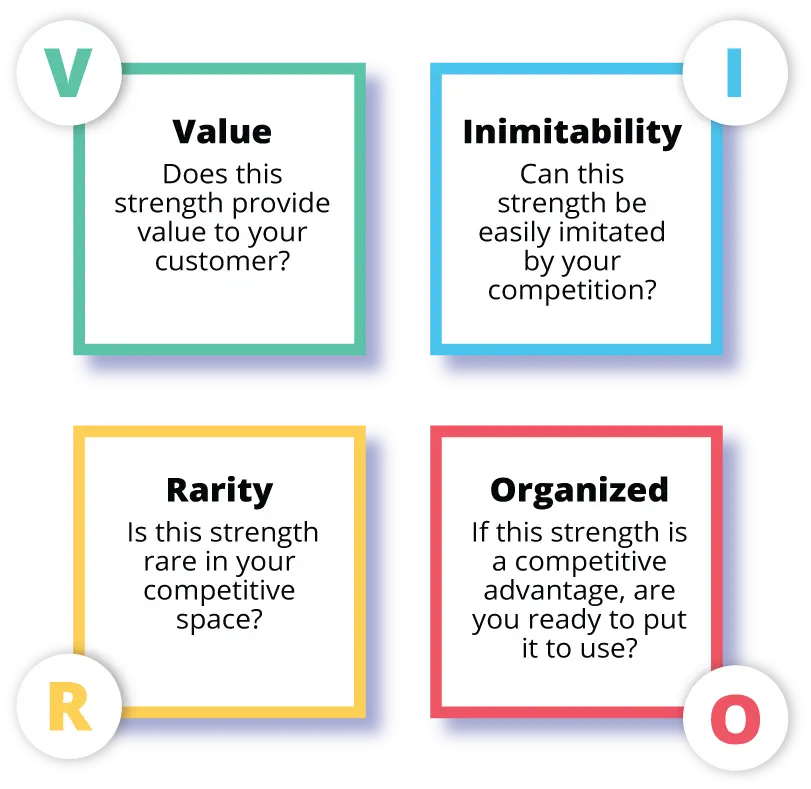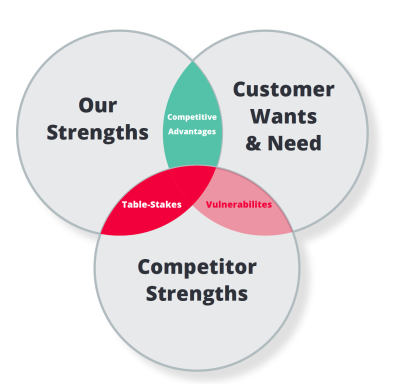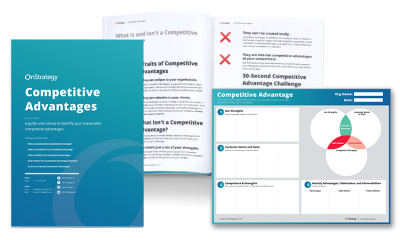What are Sustainable Competitive Advantages?
A sustainable competitive advantage is a unique competitive edge that allows an organization to outperform its competitors consistently over a long period. This advantage is sustainable when it is difficult for competitors to duplicate or replicate or neutralize.
Sustainable competitive advantages answer the question, “What are we best at in our market?” The answer creates a set of 2-3 long-term, unique strengths that a customer values.
Your competitive advantage is what you, your company, or your department does better than anyone else. The sustainable part refers to your ability to continue doing those things long-term. And yes, you can have more than one advantage, and you can also develop advantages. However, you don’t have to possess them all now.
Video Transcript – Sustainable Competitive Advantages-The Virtual Strategist
Hi, I’m Erica Olson with OnStrategy. Today’s whiteboard video is part of our series on how to develop your growth strategy. Today we’re specifically digging into How to win. This is in the context of where to play, how to win, how are we going to grow. So digging deep on how to win is really unpacking what are your current competitive advantages and what do they need to be.
So there’s a couple of ways we’re going to go about that. We’re going to take it from a strengths perspective and we’re going to take it from a competitor perspective. So let’s jump in. So, coming into this exercise, I’m going to assume that you’ve built out your SWOT. So you’re going to take the strengths from your SWOT, and from each of your strengths, you’re going to ask yourself, is that strength different from your competitors, meaning your competitors don’t have that strength.
If you answer yes, we’re going to check the box off. Do your customers value that strength? If they do, we’re going to say yes. and check the box. Is it hard to imitate, or I said hard ish to imitate, because actually everything’s imitatable really at the end of the day, but hard ish to imitate. If the answer is yes, we’re going to check the box.
So that particular strength, maybe it’s your brand, I’ll just use that as an example, uh, would then be considered a competitive advantage. If you answer no to any of these, then that strength is not a competitive advantage, but maybe it needs to be. So you would go through that for each of your strengths to determine what are your current competitive advantages and what might they need to be.
So, that’s part one. Part two, let’s take it from a different lens. Let’s take it from a competitive analysis perspective. So, Pulling out a grid again for each of your competitors. Let’s pick your top competitors. Some people have a lot of competitors, or there might be so many competitors that you might need to group them.
So either way, let’s say your top five, just to make it easy for each of them. You’re going to want to ask yourself, why does that competitor win? Or why do you think that that competitor wins? And you just sort of, you know, answer that. Um, why do they lose? And you’ll answer that. And where do you think they’re going over the next five years?
And you answer that you repeat that for each of your competitors, which is kind of a light competitive analysis. When you look back and zoom back for just a second, you’re going to identify. Some places why you’re winning and they’re losing right here. And those are potentially competitive advantages or things that you’re best at that your competitors are not.
So again, it’s a little bit non linear, but absolutely stuff will pop out for you. Awesome exercise. Your team will love it. So you’re going to bring that all together and you’ll probably have a list of hopefully, you know, maybe five, maybe seven things that you are. Best at, and again, that’s a little bit, uh, tall order.
I would say to say that you’re best at something, but better than your competitors, if that feels a little bit better and that your customers value. You’re also going to, by default, identify those that you need to be best at. And let’s put those off to the side. We’re going to build that into your goals and initiatives, but those are that’s gold.
That’s great stuff. So keep that when you build out your plan. So if you zoom all the way back out, you know, we’re trying to answer the question, how will we win? We win by being best at something better than our competitors and driving value to our customers. When you look at it, there are three different ways that you can be differentiated, or three different ways that you can win if you were to summarize all this and stand back and look at it.
Um, and this is based on Michael Porter’s three generic strategies. One is on speed, so getting to market fastest. One is on scale, which is being the total lowest cost, not, not the cheapest, just the total lowest cost. And one is on scope, meaning being the best at delivering that unique value proposition to that customer in a very niche manner.
Um, there’s a lot more to read on this, certainly dig in, Google it, see all the paragraphs that kind of unpack this further, but you’re going to know if you had to choose one of these, that is how you are the most differentiated and more different than your competitors and syncs with your competitive advantages, you would pick one.
In this case, we’re just going to pick scale. So when we’re done with this exercise, we’re looking for three to seven competitive advantages that you have today, ideally, maybe some that you’re going to work on and we’re gonna put those off to the side and a summary of how you’re going to be differentiated.
You’ll bring that into the next step when we summarize your growth strategies. So check out the video on how to do that. Thanks for tuning in. Subscribe to our channel. Happy strategizing.
What are the Two Traits of Sustainable Competitive Advantage?
#1 They are unique to your organization.
Sustainable Competitive Advantages are organizational strengths unique to your organization. These are the strengths that set you apart from your competition. It’s what you do well and is distinctly valuable in your market.
Get the Free Guide and Canvas to Build a Solid Growth Strategy
#2 They are valuable to your clients.
Competitive Advantages are traits or strengths important to your clients. If the strength you’ve identified is essential to you but not crucial to your client, it’s not a sustainable competitive advantage. A competitive advantage is a strength or reason your clients choose you over your competition. It must have value to your customer!
What isn’t a Sustainable Competitive Advantage?
We see organizations incorrectly identify competitive advantages all the time. It happens, but here are a few quick ways to know if what you’re looking at is truly an advantage.
Competitive advantages are not a list of your strengths.
Often starting with what something isn’t is easiest. Your competitive advantage is not a list of your strengths. Strengths can become competitive advantages, but they are not just a list of all your strengths.
They can’t be created easily.
Competitive advantages, by definition, are not easy to create or replicate. If they’re easily created or copied, they might be growth opportunities instead. Sustainable competitive advantages are long(er) term in nature, meaning it takes time for a competitor to replicate it.
They are also not competitive advantages of your competitors.
We see this one common mistake again and again in identifying competitive advantages – a competitive advantage is not a strength you have because your competition also has it. Strengths that keep you competitive in your market are essential but are considered table-stakes. Essentially, they are the required strengths to keep your organization at the table in the marketplace.

The 30-Second Sustainable Competitive Advantage Challenge
Here’s the 30-second challenge to determine if you know your competitive advantage. Ready? Go. I meet you at one of the numerous local networking events, and you introduce yourself. “Hi, I’m Bob Jones with ABC Company.” “Hi, Bob. Nice to meet you. Tell me a little about your company. What is your company best at?”
… 29, 30. Time’s up! Could you answer this question in less than 30 seconds, succinctly with clarity?
When you can, you know you’ve identified your competitive advantages.
Formula for a Sustainable Competitive Advantage Statement
Let’s go back to the fictitious networking event from the beginning. We said you need to answer the question “What is your company best at” within 30 seconds. The formula below helps answer that question clearly:
| FORMULA FOR A COMPETITIVE ADVANTAGE | ||
| A statement that explains what your company is best at. | ||
| Your business name | + What you are best at | + Why |
| Honda | is best at developing precision engines and power trains | because its products are the leaders in reliability and technological advancement |
| Bikram Yoga | is best at productizing the yoga experience and practice | because it is packaged for franchising |
| is best at optimizing searches for any type of information | because it continues to innovate and push technology past what was thought possible | |
| Now it’s your turn… | ||
How to Identify Your Competitive Advantages

We have a comprehensive exercise in this guide and this post on identifying your competitive advantages. There is also a helpful exercise, called a VRIO framework, that can help you identify your sustainable competitive advantages. Here’s a quick overview of how to identify your competitive advantages:
- Identify strengths. From the strengths section in your SWOT, identify your most valuable strengths.
- Identify customer wants/needs. From your customer research or customer analysis, identify your customer’s top wants and needs that you can solve.
- Find the overlap. From your list of customer strengths, find the overlap between strengths you possess that provide value or solve your customer needs.
- Axe the strengths your competitors also possess. Sustainable competitive advantages must be unique. If your competitor also has it, it’s not a competitive advantage. It’s a table stake.

So, Why Do You Need to Identify Your Sustainable Competitive Advantages?
The short answer is this: knowing your competitive advantages helps you build a better, more thoughtful growth strategy. As part of our growth strategy series, understanding your competitive advantages helps answer the question, “How do you win?”.
You need to know what your organization is best at to help build a thoughtful growth strategy. Need help creating a growth strategy? Check out our comprehensive guide and canvas here.
Pro-tip: Think of competitive advantages like your competitive moat.
What are the strengths you have that help keep your organization protected from the threat of competition? Moats are hard to build and penetrate. Competitive advantages are too.













From my organization, we operate a state of art hospital what keeps us above our immediate competitor is our free counselling services we offer for our clients. This includes even those who are not our patients. The knowledge of competitive advantage as explained in this article is so helpful and practical